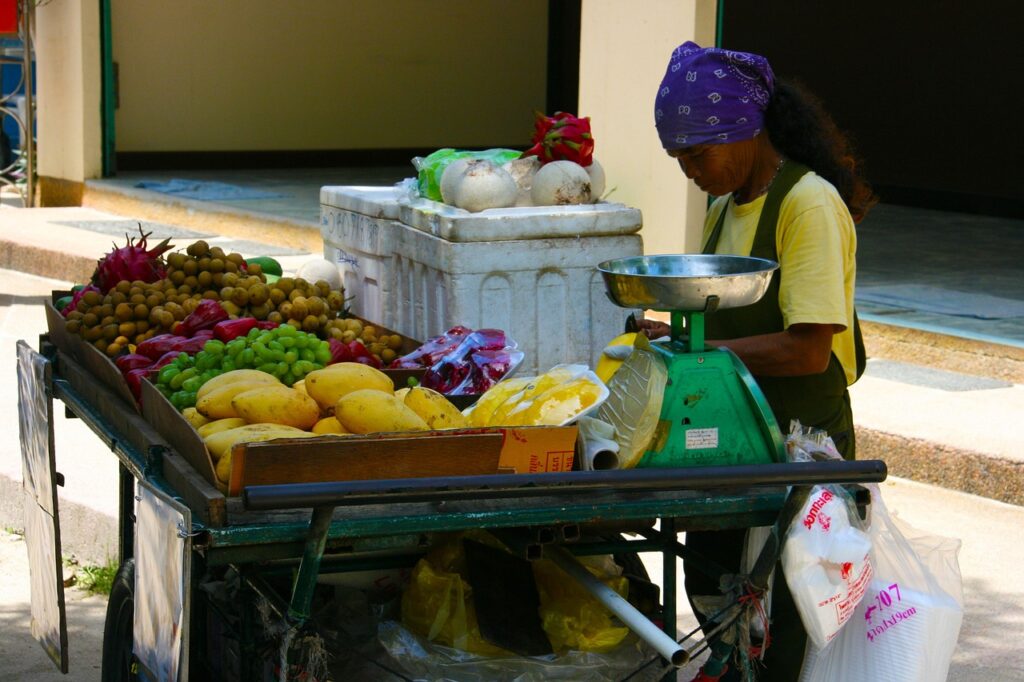* see below for updated project objectives

Why migration & urban diets?
Future cities
The global population is projected to keep increasing until the end of the century, and the percentage of this population living in urban areas will likely be around 68% by 2050. This means that most people on the planet will be living, buying, and eating within urban food systems, and global food systems are already transitioning to meet the demands that come with this. At the same time, this growing population will put a lot of pressure on the world’s food supply, which is already under pressure from impacts of climate change and other factors. We are also dealing with a wide spectrum of nutrition-related health issues, from obesity to undernutrition. If we are going to be able to feed everyone a healthy diet, we need to understand our food systems and how we can transform them to be more sustainable and healthy.
Human migration
So where does migration come in? Well, urban populations grow for two reasons: people in urban areas have children, and people migrate in from rural or other urban areas. Often, people migrate to cities for better opportunities or education, and they bring with them their customs, their languages, and – importantly – their food. This transfer of cultural elements is what creates that “melting pot” environment for which cities are so famous.
So, when a person migrates to an urban area, do they continue to eat what they normally would? If so, they might create new demands on that city’s food system, and perhaps influence the diets of others. Or, do they adopt the diets that exist in that urban area? If so, their diets may become either healthier or less healthy. There is also a third option: fusion. Perhaps migrants tend to adhere to their traditional diets to some extent, but also incorporate elements of the urban diet. This could have mixed impacts on food systems.

This project
What we’re seeking to understand through this research is whether the interplay between traditional, non-traditional, and fusion diets result in more or less sustainable and healthy diets in urban areas. To that end, this project will look at the demographic growth in Hanoi, Cali, and Bahir Dar over time with a particular focus on ethnicity, which tends to be an indicator of dietary custom and preferences. The components of each migrant group’s diet will then be analyzed with the aim of understanding each diet’s environmental footprint and potential health outcomes. We hope to utilize a survey in one of the cities to measure the extent to which different
migrant groups adhere to their traditional diets and/or adopt non-traditional diets. Once we have all this data, we aim to generate projections to 2050 and 2100 for a ‘business-as-usual’ scenario as well as other scenarios that include potential changes to food systems, migration, climate change mitigation, etc. These projections can help inform policymakers and other stakeholders about the relationship between migration and sustainable food system transformations, and hopefully guide their decisions toward outcomes that prioritize sustainability and health.
I’m so enthralled by the questions that are coming up, the challenges and creativity in the research process, and the bigger picture this project fits into. We are all connected to food and our food systems are living parts of our communities. I hope you’ll come along as I hash things out here on the blog platform.
15 April, 2023
UPDATE
The Rolling Road of Research

If you’ve read the original Project Introduction, you know my research is aimed at determining what (if any) changes are made to migrant diets when they move to an urban area (Cali, Bahir Dar, and Hanoi in this case) and how those changes impact the health and sustainability outcomes of the urban area’s food system. After just over two months of research, I have learned a very valuable lesson about research: the road you walk doesn’t always look like the one on the map.
My research period is quite short — only four months from first day to final draft — and that time constraint is a barrier to collecting primary data, which requires ethics approval, survey drafting, dissemination, and analysis. However, after weeks of researching, I concluded that there also just wasn’t enough secondary data in these three cities to answer my research question. Census data was not complete or detailed enough to give me an accurate picture of the demographic changes over time, data on dietary components (especially disaggregated by ethnicity) did not seem to exist anywhere, and on top of this, migration is such a complex, resource-intensive thing to measure that many sources I found had outdated migration data. When I realized what a lack of useful information I had after weeks of scouring datasets and papers, I was disappointed. It felt like my project might not succeed. But then I realized how interesting it was that I couldn’t answer my research question with the data available, because that suggested something I hadn’t expected: there are gaps in this area of study.
As it turns out, studying post-migration dietary change is an area picking up speed in the research world, with several papers published in the last ten years or so. However, when I compared the topics of 40 of these papers, I found some interesting patterns. Most of the studies agreed on one thing: most migrants moving to new areas adopted more “western,” “modern,” or “industrialized” ways of eating (we’ll unpack what that means in a different post). But most of the studies looked at migrants moving from developing countries to developed countries, with only a few looking into internal rural-urban migration within developing countries. About half the studies looked specifically at the role of migrant dietary changes in health outcomes, such as the risk of developing a diet-related disease like obesity, high blood pressure, or metabolic syndrome. Zero of these studies aimed to determine the sustainability outcomes from migrant dietary changes. I had myself a gap.
My thesis supervisors and fellow researchers suggested I shift from viewing my project as a study to viewing it as a piece of thought leadership, with the new end product being a Perspective Paper. A Perspective is a mix between a literature review and an opinion; it proposes a new perspective on an area of research and then backs it up with evidence. The result can be that future research is nudged in a certain direction.
So, my new objective is clear: to write a Perspective paper that argues for the collection and use of migrant dietary change data on the city-region level to determine the impact of the changes on urban food system sustainability. Using this data, urban areas can leverage migrant dietary habits toward food system sustainability.
Has this project followed the road I laid down on the map? No. But I’ve learned that this is normal in research, and I’ve learned to adapt. I’ve learned that the way the face of a project morphs as questions are answered (and not answered) along the way is the research. And that’s what I’m here to do: learn.
Now that I’ve got my feet on the ground and am beginning to draft my paper, I’m excited to share some ideas and information on migration, diets, and urban food systems in the blog posts.
26 June, 2023
